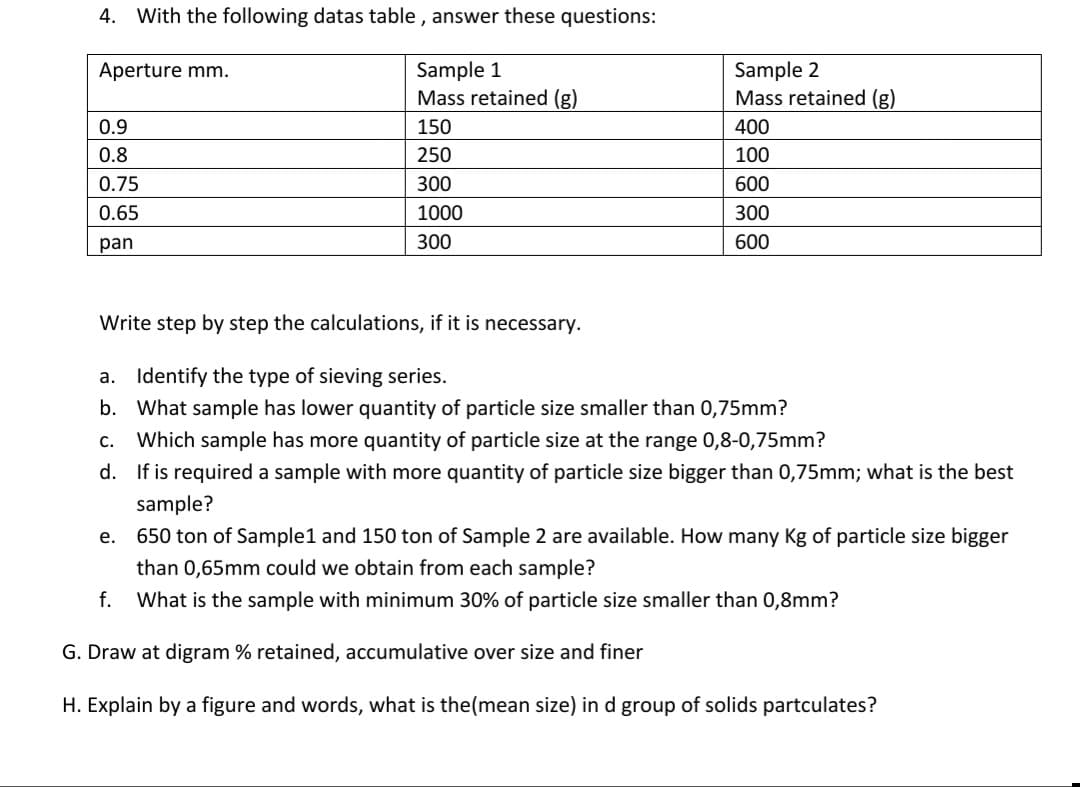Write step by step the calculations, if it is necessary. a. Identify the type of sieving series. b. What sample has lower quantity of particle size smaller than 0,75mm? c. Which sample has more quantity of particle size at the range 0,8-0,75mm?
Write step by step the calculations, if it is necessary. a. Identify the type of sieving series. b. What sample has lower quantity of particle size smaller than 0,75mm? c. Which sample has more quantity of particle size at the range 0,8-0,75mm?
Chapter2: Loads On Structures
Section: Chapter Questions
Problem 1P
Related questions
Question

Transcribed Image Text:4. With the following datas table , answer these questions:
Sample 1
Mass retained (g)
Sample 2
Mass retained (g)
Aperture mm.
0.9
150
400
0.8
250
100
0.75
300
600
0.65
1000
300
pan
300
600
Write step by step the calculations, if it is necessary.
a. Identify the type of sieving series.
b. What sample has lower quantity of particle size smaller than 0,75mm?
С.
Which sample has more quantity of particle size at the range 0,8-0,75mm?
d. If is required a sample with more quantity of particle size bigger than 0,75mm; what is the best
sample?
650 ton of Sample1 and 150 ton of Sample 2 are available. How many Kg of particle size bigger
е.
than 0,65mm could we obtain from each sample?
f.
What is the sample with minimum 30% of particle size smaller than 0,8mm?
G. Draw at digram % retained, accumulative over size and finer
H. Explain by a figure and words, what is the(mean size) in d group of solids partculates?
Expert Solution
This question has been solved!
Explore an expertly crafted, step-by-step solution for a thorough understanding of key concepts.
Step by step
Solved in 3 steps

Knowledge Booster
Learn more about
Need a deep-dive on the concept behind this application? Look no further. Learn more about this topic, civil-engineering and related others by exploring similar questions and additional content below.Recommended textbooks for you


Structural Analysis (10th Edition)
Civil Engineering
ISBN:
9780134610672
Author:
Russell C. Hibbeler
Publisher:
PEARSON

Principles of Foundation Engineering (MindTap Cou…
Civil Engineering
ISBN:
9781337705028
Author:
Braja M. Das, Nagaratnam Sivakugan
Publisher:
Cengage Learning


Structural Analysis (10th Edition)
Civil Engineering
ISBN:
9780134610672
Author:
Russell C. Hibbeler
Publisher:
PEARSON

Principles of Foundation Engineering (MindTap Cou…
Civil Engineering
ISBN:
9781337705028
Author:
Braja M. Das, Nagaratnam Sivakugan
Publisher:
Cengage Learning

Fundamentals of Structural Analysis
Civil Engineering
ISBN:
9780073398006
Author:
Kenneth M. Leet Emeritus, Chia-Ming Uang, Joel Lanning
Publisher:
McGraw-Hill Education


Traffic and Highway Engineering
Civil Engineering
ISBN:
9781305156241
Author:
Garber, Nicholas J.
Publisher:
Cengage Learning